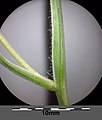Meadow yellow star
| Meadow yellow star | ||||||||||||
|---|---|---|---|---|---|---|---|---|---|---|---|---|

Meadow Yellow Star ( Gagea pratensis ) |
||||||||||||
| Systematics | ||||||||||||
|
||||||||||||
| Scientific name | ||||||||||||
| Gagea pratensis | ||||||||||||
| (Dum.) |
The meadow yellow star ( Gagea pratensis ), also known as meadow gold star , belongs to the genus yellow star ( Gagea ), and thus to the lily family (Liliaceae). As a further trivial names also are arable onion and field onion occupied.
description
The meadow yellow star is a delicate perennial herbaceous bulb plant ( geophyte ) that blooms in early spring (usually in April) and reaches heights of 8 to 20 cm. The beginning of flowering is usually a few days after the field yellow star .
The plant has only one basal leaf that is 2 to 4 mm wide and has a V-shaped leaf cross-section. It has a deep groove on the top - in contrast to the forest yellow star , in which the thread-like youth leaves are pentagonal or have a flattened top. The bracts are ciliate. The lowest stem leaf usually clearly towers above the inflorescence with its one to six flowers. The six golden-yellow to greenish-yellow tepals and the flower stalks show no hair - in contrast to the field yellow star . The tepals are not pointed, they taper off slightly. The plant has a main bulb with 2 bare, lying, yellowish secondary bulbs.
The number of chromosomes is 2n = 36, 48 or 60.
Occurrence
The somewhat heat-loving species prefers moderately dry, clay and loess soils. It occurs mainly in societies of the order Polygono-Chenopodietalia but also in the associations Mesobromion or Alysso-Sedion.
The species used to be found in fields and vineyards as well as on fresh meadows and pastures. Due to changes in the type of soil cultivation, the meadow yellow star has largely disappeared from fields and has become significantly less common in vineyards. The meadow yellow star prefers to settle in the grassland near fruit trees, it is also found more frequently on horse pastures than on cattle pastures, and even less often in pure hay meadows . Frequently (often sterile) occurrences are in cemeteries and in parks. The species here is an indication of the previous rural use of the facilities.
In some years the species is difficult to find due to the lack of flowering.
distribution
The meadow yellow star is a temperate continental species that is widespread in large parts of Central and Eastern Europe. The range extends from Europe to north-western Turkey. In Germany it occurs only very scattered or rarely, it is absent in large parts of Baden-Württemberg, in southern Bavaria and in northwest Germany and is on the red list of endangered species in most federal states . The species does not occur in Great Britain or Norway.
Related species
Related types are the field yellow star , the forest yellow star , the sheath yellow star and the small yellow star . Some authors give a hybrid clan between Gagea lutea x pratensis, which is called Gagea pomeranica.
literature
- U. Raabe: Gold star deposits in cemeteries in the eastern Münsterland . in Göttinger Florist Rundbriefe, Volume 15, Issue 4, Pages 77-82. Göttingen, 1981.
- Werner Rothmaler : excursion flora - critical volume. Spectrum Academic Publishing House, 2005, ISBN 3827416000 .
- Look up further literature on Gagea pratensis in the vegetation ecology literature database
References
- ^ Georg August Pritzel , Carl Jessen : The German folk names of plants. New contribution to the German linguistic treasure. Philipp Cohen, Hannover 1882, p. 157, archive.org
- ^ Gagea identification key
- ↑ Identification key Gagea II
- ↑ a b Erich Oberdorfer : Plant-sociological excursion flora for Germany and neighboring areas . With the collaboration of Angelika Schwabe and Theo Müller. 8th, heavily revised and expanded edition. Eugen Ulmer, Stuttgart (Hohenheim) 2001, ISBN 3-8001-3131-5 , pp. 125 .
- ↑ first Raabe 1981
- ↑ Rafaël Govaerts (ed.): Gagea pratensis. In: World Checklist of Selected Plant Families (WCSP) - The Board of Trustees of the Royal Botanic Gardens, Kew . Retrieved September 29, 2016.
- ↑ JOHN PETERSON & PETERSON 2004: For taxonomic rank of two critical taxa of the genus Gagea in Central Europe. Mitt. Florist. Map of Saxony-Anhalt (Halle) 9: 15-2615
- ↑ TANJA PFEIFFER, DAVID EV HARTER, NOREEN FORMELLA and MARTIN SCHNITTLER (2013): Reproductive isolation vs. interbreeding between Gagea lutea (L.) Ker Gawl. and G. pratensis (Pers.) Dumort. (Liliaceae) and their putative hybrids in Mecklenburg-Western Pomerania (Germany)
Web links
- Gagea pratensis. In: FloraWeb.de.
- Meadow yellow star . In: BiolFlor, the database of biological-ecological characteristics of the flora of Germany.
- Profile and distribution map for Bavaria . In: Botanical Information Hub of Bavaria .
- Gagea pratensis (Pers.) Dumort., Map for distribution in Switzerland In: Info Flora , the national data and information center for Swiss flora .
- Swiss Species Protection Leaflet Wiesen-Gelbstern (PDF file; 698 kB)
- Distribution in the northern hemisphere
- Meadow yellow star in Norway (swed.)
- Thomas Meyer: Data sheet with identification key and photos at Flora-de: Flora von Deutschland (old name of the website: Flowers in Swabia )
- Botanical Herbarium Czech Republic (Czech)
- Photographs of wild plants
- Leaf cross-sections of meadow yellow stars




